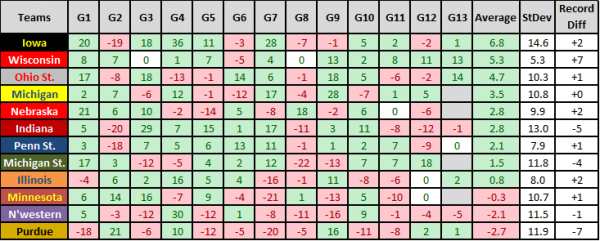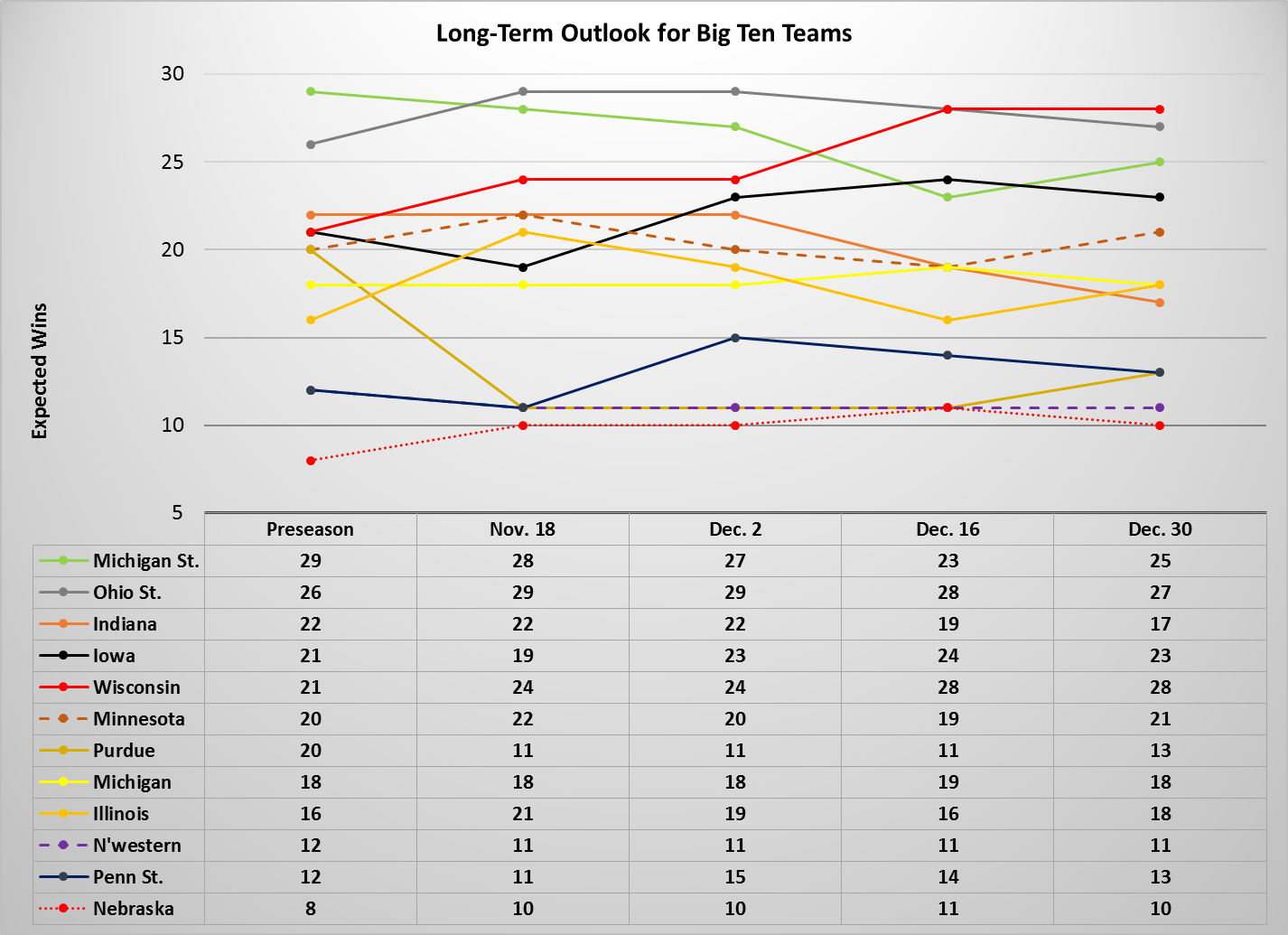Big Ten Analysis: Wisconsin Leads the Way, Ohio State Right Behind…
Posted by Alex Moscoso (@AlexPMoscoso) on December 31st, 2013The non-conference part of the season is finally over and so is our ongoing series of measuring Big Ten teams’ non-conference performance with their preseason expectations. We have continuously recorded the score for each team’s game and compared that performance to their preseason expected performance from KenPom.com. The table below displays our final performance statistics for each team during the non-conference season. It shows whether a team underperformed (marked in red) or overperformed (marked in green) in each of their games (G1 through G13), if they’ve underperformed or overperformed throughout the season (Average), their consistency (StDev), and the change in their long-term outlook (Record Diff). For additional context, feel free to check out the December 17, December 3, and November 18 versions of this analysis.
Here are our final takeaways from this analysis:
- Iowa has been the most overperforming team this season. The Hawkeyes are no strangers to this spot of our analysis, as they’ve been the most overperforming team in each post of this series. Fran McCaffery has used his high-powered offense (ninth in adjusted offensive efficiency) and deep bench to blow out teams like UNC-Wilmington and Abilene Christian early in the season. In the Battle 4 Atlantis, they also had a successful run, falling just short of winning the championship against Villanova, but putting in an impressive showing nevertheless. As a result, they’ve overperformed by an average of 6.8 points per game. They’ve fallen back to earth a bit recently — not overperforming by more than five points in the last four games — but have still more than lived up to the hype placed upon them before the season.
- Purdue has been the most underperforming team and has hurt its long-term prospects the most. The Boilermakers’ season has been nothing short of disappointing. There were signs things were not going well even before their first loss; they nearly lost early contests to Northern Kentucky and Rider. The rubber finally met the road in the Old Spice Classic when they were easily handled by Oklahoma State and upset by an inferior Washington State team. From that low point, Purdue has managed to register wins against several other underperforming teams like Boston College and West Virginia. On average, the team has underperformed by 2.7 points per game and, as a result, their number of expected wins has decreased by seven from their original preseason expectations. They are currently expected to win a total of 13 games, a disheartening prediction from a team that looked to challenge for a bid in the NCAA Tournament.
- Wisconsin has improved its long-term prospects the most. While Iowa has been the most overperforming team in the Big Ten, the Badgers have been the most impressive team. Not only have they gone undefeated through 13 games, but they’ve done so by playing the most difficult schedule in the league (six wins against the RPI top 100). Things went well from the get-go when the Badgers put on an impressive performance in a win against an athletic St. John’s team and a week later defeated annual Final Four contender, Florida. Wisconsin is now expected to finish with seven additional wins than expected in the preseason. The difference has been the offensive prowess of this year’s team — four of the starters are averaging double-figure points per game and all of them have the ability to score in bunches. Add in the typical Bo Ryan high-quality defense and error-free basketball, and Wisconsin may have its best team since 2008, the year of its last Big Ten championship.
Finally, the chart above shows the changing level of long-term expectations in expected wins for each team throughout the non-conference season. Each point, or milestone, represents when we’ve updated and posted this analysis. Wisconsin has pulled ahead of Ohio State in expected number of wins (28 to 27) and Nebraska, while improving its stock since the preseason, is still expected to finish with the least number of wins (10). According to KenPom, the Big Ten is supposed to finish in the following order: Wisconsin, Ohio St., Michigan State, Iowa, Michigan and Minnesota (tied), Illinois and Indiana (tied), Penn State and Purdue (tied), and Nebraska and Northwestern (tied). Let’s tip it off today and see whether the numbers match reality.














































